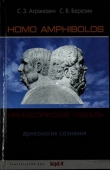
Текст книги "Эволюционная психология. Секреты поведения Homo sapiens"
Автор книги: Джек Палмер
Соавторы: Линда Палмер
Жанры:
Психология
,сообщить о нарушении
Текущая страница: 30 (всего у книги 31 страниц)
Список использованной литературы.
Aiken, N. (1998). The biological origin of art. West-port, CT: Praeger.
Alcock, J. (1984). Animal behavior: An evolutionary approach. Sunderland, MA' Sinauer Assoc.
Alexander, R. (1987). The biology of moral systems. New York: Aldine de Gruyter.
Alexander, R., Hoodland J., Howard, R, Noo-nan, K., & Sherman, P. (1979). Sexual dimorphism and breeding systems in pinnepeds, ungulates, primates and humans. In N. A. Chagnon & W. Irons (Eds.), Evolutionary biology and human social behavior. North Scituate, MA: Duxbury Press.
Altaian, W. R (1995). The stone age present: How evolution has shaped modern life – from sex, violence, and language to emotions, morals, and communities. New York: Touchstone.
Allport, G. (1937). Personality: A psychological interpretation. New York: Holt, Rinehart & Winston.
American Psychiatric Association. (1994). Diagnostic and statistical manual of mental disorders (4th ed.). Washington, DC: American Psychiatric Association.
Aristophanes (1962). The frogs. Ann Arbor, MI: University of Michigan Press. (Original work published 405 B.C.)
Aristotle (1937). Parts of animals. Cambridge, MA: Harvard University Press. (Original work published 350 B.C.)
AtkinsonJ. W (1958). Motives in fantasy action and society. Princeton: Van Nostrand.
Atran, S. (1999). The universal primacy of generic species in folk-biological taxonomy: Implications for human biological, cultural, and scientific evolution. In R. A. Wilson (Ed.), Species: New interdisciplinary essays Cambridge, MA: MIT Press.
Avise, C. J. (1998). The genetic gods: Evolution and belief in human affairs. Cambridge, MA: Harvard University Press.
Baker, R. (1996). Sperm wars: The science of sex. New York: Basic Books.
Baker, R. R., & Bellis, M. A. (1995). Human sperm competition: Copulation, masturbation, and infidelity. London: Chapman and Hall.
Barkow, J., Cosmides, L, & Tooby, J. (Eds.). (1992). The adapted mind: Evolutionary psychology and the generation of culture. New York: Oxford University Press.
Barrow.J. D. (1994). The origin of the universe. New York: Basic Books.
Beck, B. B. (1986). Tools and intelligence. In R J. Hoage & L. Goldman (Eds.), Animal Intelligence. Washington, D.C. & London: Smithsonian Press.
Beck, B. B. (1980). Animal tool behavior: The use and manufacture of tools by animals. New York: Garland.
Betzig, L. (1993). Sex, succession, and statification in the first six civilizations. In Ellis, L. (Ed.) Social Stratification and Socioeconomic Inequality: Vol. I. Westport, CT: Praeger Publishers.
Bodmer, W, & McKie, R. (1994). The book of man: The Human Cenome Project and the quest to discover our genetic heritage. New York: Scribner.
Boring, E. G. (1950). A history of psychology. Cambridge, MA: Harvard University Press.
Bowlby, J. (1967). Attachment and loss: Vol.1. Attachment. New York: Basic Books
Box, H. 0. (1984). Primate behaviour and social ecology. New York: Chapman and Hall Ltd.
Bradie,M.(1994).TheSecretChain: Evolutionand Ethics. Albany, NY: State University of New York Press.
Buss, A., & Plomin, R. (1986). The EAS approach to temperament. In R. Plomin & J. Dunn (Eds.), The study of temperament: Changes, continuities and challenges Mahwah, NJ: Eri-baum.
Buss, D. M. (1994). The evolution of desire. New York: Basic Books.
Buss, D. M. (1998). The psychology of human mate selection: Exploring the complexity of the strategic repertoire. In C. Crawford & D. L Krebs (Eds.), Handbook of evolutionary psychology: Ideas, issues, and applications. Mahwah, NJ: Eribaum.
Calder, N. (1983). Timescale: An atlas of the fourth dimension. New York: The Viking Press.
Calvin, W. H., & Bickerton, D. (1998). Lingua ex machina: Reconciling Darwin and Chomsky with the human brain. Cambridge, MA: MIT Press.
Calvin, W. Н. (1982). The throwing Madonna: Essays on the brain. New York: McGraw-Hill.
Candland, D. K. (1993). Feral children and clever animals: Reflections on human nature. New York: Oxford University Press.
Caramazza, A. (2000). The organization of conceptual knowledge in the brain. In M. S. Gaz-zaniga (Ed.), The new cognitive neurosciences, 2nd ed. Cambridge, MA: The MIT Press.
Carlson, N. R. (1998). Physiology of behavior (6th ed.). Boston: Allyn and Bacon.
Carter, C. S. (1992). Hormonal influences on human sexual behavior. In J. B. Becker, S. M. Breedlove, & D. Crews (Eds.), Behavioral endocrinology Cambridge, MA: MIT Press.
Cattell, R. B. (1965). The scientific analysis of personality. London: Penguin Books, Limited.
Cattell, R. B. (1972a). A new morality from science: Beyondism. Elmsford, NY: Pergamon Press Inc.
Cattell, R. B. (1972b). Measurement of mood and personality by questionnaire. New York: Random House.
Chagnon, N. A. (1992). Yanomamo: The last days of Eden. New York: Harcourt Brace.
Chavet, J. M. C., Deschamps, E. В., & Hillaire, C. (1996). Dawn of art: The Chauvet Cave. New York: Abrams.
Cheney, D. L., & Seyfarth, S. M. (1990). How monkeys see the world. Chicago: Chicago University Press.
Cheney, D. L, & Seyfarth, R. M. (1991). Truth and deception in animal communication. In C. A. Ristau (Ed.), Cognitive ethology: The minds of other animals. Hillsdale, NJ: Eribaum.
Chess, S., & Thomas, A. (1984). Origins and evolution of behavior disorders. New York: Brun-ner/ Mazel.
Choi, J., & Silverman, I. (1996). Sex differences in spatial mapping strategies. Paper presented at the meeting of the Human Behavior and Evolution Society Conference presented in Evanston, IL.
Clutton-Brock, T. (Ed.). (1988). Reproductive success: Studies of individual variation in contrasting breeding systems. Chicago: University of Chicago Press.
Cohen, D. B. (1999). Stranger in the nest: Do parents really shape their child's personality, intelligence, or character? New York: John Wiley & Sons.
Corballis, M. C. (1991). The lopsided ape: Involution of the generative mind. New York: Oxford University Press.
Cosmides, L., & Tooby, J. (1992). Cognitive adaptations for social exchange. In J. Barkow, L. Cosmides, & J. Tooby (Eds.), The adapted mind: Evolutionary psychology and the generation of culture. New York: Oxford University Press.
Cosmides, L., & Tooby, J. (1997). Evolutionary psychology: A primer [On-Line]. Available: http:// www.psych.ucsb.edu/research/cep/primer.htm
Cosmides, L., & Tooby, J. (2000). The cognitive neuroscience of social reasoning. In M. S. Gazzaniga (Ed.), The New Cognitive Neuro-sciences, 2nd ed. Cambridge, MA: MIT Press.
Costa, P. T, Jr, & McCrae, R. R. (1998). Trait theories of personality. In D. R Barone & M. Hersen (Eds.), Advanced personality. The Plenum series in social/clinical psychology. New York: Plenum Press.
Crick, E (1981). Fife itself: Its origin and nature. New York, NY: Simon and Schuster.
Crick, E (1994). The astonishing hypothesis: The scientific search for the soul. New York: Charles Scribner's Sons.
Cronin, C. (1980). Dominance relations and females. In D. Omark, E Strayer, & D. Freeman(Eds.), Dominance Relations: An Ethological View of Human Conflict and Social Interaction. New York: Garland Publishing, Inc.
Curtiss, S. (1989). The independence and task-specificity of language. In A Bornstain & J.
Bruner (Eds.). Interaction in human development. Hillsdale, NJ: Eribaum.
Daly, M., & Wilson, M. (1995). Discriminative parental solicitude and the relevance of evolutionary models to the analysis of motivational systems. In M. S. Gazzaniga (Ed.). The cognitive neurosciences. Cambridge, MA: MIT Press.
Daly, M., & Wilson, M. (1998) The evolutionary social psychology of family violence. In С. В. Crawford, D. L. Krebs, et al. (Eds.), Handbook of evolutionary psychology: Ideas, issues, and applications. Mahwah, NJ: Eribaum.
Darwin, C. (1859). On the origin of species by means of natural selection. London: Murray.
Darwin, C. (1868). The voyage of the beagle. London: Heron books.
Darwin, C. (1871). The descent of man, and selection in relation to sex (2nd ed.). London: Murray.
Darwin, C. (1872). The expression of the emotions in man and animals. London: Murray.
Darwin, F. (1887). The life and letters of Charles Darwin. New York: Appleton.
Dasser, V. (1985). Cognitive complexity in primate social relationships. In R. A. Hinde, A. N. Perret-Clemont, & J. Stevenson-Hinde (Eds.), Social relationships and cognitive development. Oxford: Clarendon Press.
Davies, P. (1994). The last three minutes. New York: Basic Books.
Davis, K. (1948). Human society. New York: MacMillan.
Dawkins, R. (1989). The. selfish gene (2nd ed.). Oxford: Oxford University Press
De Waal, F. (1982). Chimpanzee politics. London: Jonathan Cape.
Dennett, D. (1995). Darwin's dangerous idea: Evolution and the meaning of life. New York: Simon & Schuster.
Diamond, J. M. (1992). The third chimpanzee: The evolution and future of the human animal. New York: Harper Collins.
Diamond, M. C. (1988). Enriching heredity: The impact of the environment on the anatomy of the brain. New York: Free Press.
Dissanayake. E. (1988). What is art for? Seattle, WA: University of Washington Press.
Dissanayake, E. (1992). Homo Aestheticus: Where art comes from and why. New York: Free Press.
Dissanayake, E. (1999). «Making Special»: An un-described human universal and the core of a behavior of art. In В. Cooke & F. Turner (Eds.), Biopoetics: Evolutionary exploration in the arts. Icus Books Pub.
Bollard J./ & Miller, N. (1950). Personality and psychotherapy: An analysis in terms of learning, thinking, and culture. New York: McGraw-Hill.
Dunbar, R. (1996). Grooming, gossip, and the evolution of language. Cambridge, MA: Harvard University Press.
Eaton, B. S., Eaton, S. В., Ill, & Konner, M. J. (1999). Paleolithic nutrition revisited. In W. R. Tre-vathan, E. 0. Smith, & J. J. Mckenna (Eds.), Evolutionary medicine. New York: Oxford University Press.
Edelman, G. M. (1987). Neural Darwinism. New York: Basic Books.
Eibl-Eibesfeldt, I. (1989). Human ethology. Chicago: Aldine.
Eibl-Eibesfeldt, I. (1998). Us and the others: The familial roots of ethnonationalism. In I. Eible-Eibesfeldt, & F. K. Salter, (Eds.), Indoctrinability, ideology, and warfare: Evolutionary perspectives. New York: Berghahn Books.
Elliott-Smith, G. (1927). The evolution of man. Essays. (2nd ed.) London: Oxford University Press.
Ellis, B. J., & Garber, J. (in press). Psychosocial antecedents of pubertal maturation in girls:
Parental psychopathology, stepfather presence, and family and marital stress. Child Development.
Ellis, L. (1993). Social stratification and socioeco-nomic inequality. (Vol I.) Westport, CT: Praeger Publishers.
Eysenck, H. J. (1983). A biometrical-genetical analysis of impulsive and sensation seeking behavior. In M. Zuckerman (Ed.), Biological bases of sensation seeking, impulsivity, and anxiety. Hillside, NJ: Eribaum.
Eysenck, H.J. (1999). The psychology of politics. New Brunswick, NJ: Transaction Publishers.
Eysenck, H. J., & Eysenck, M. W. (1985). Personality and individual differences: A natural science approach. New York: Plenum.
Feldman, R. S. (1999). Child development: A topical approach. Upper Saddle River, NJ: Prentice-Hall.
Fisher, H. (1998). Anatomy of love: The natural history of monogamy, adultery and divorce. New York: Norton.
Fisher, R A. (1930). The genetical theory of natural selection. Oxford: Clarendon.
Galiup, G. G. (1994). Self-recognition: Research strategies and experimental design. In S. T. Paker and R. W. Mitchell, M. L. Boccia (Eds.), Self-awareness in animals and humans: evelopmental perspectives. New York: Cambridge University Press.
Galiup, G. G., & Suarez, S. D. (1986). Self-awareness and the emergence of mind in humans and other primates. InJ. Suls & A. G. Green-wald (Eds.). ETC.
Gardner, R. (1998). The Biology of leadership. Presented at the NLU Psi Chi Distinguished Speaker Series, Northeast Louisiana University, Monroe, LA.
Gelman, S. A., Coley, J. D., & Gottfried, G. M. (1994). Essentialist beliefs in children: The acquisition of concepts and theories. In L A Hirschfeld, S. A. Gelman, etal. (Eds.), Mapping the mind: Domain specificity in cognition and culture. New York: Cambridge University Press.
Ghesquiere, J., Martin, R D, & Newcombe, E (Eds.). (1985). Human sexual dimorphism. Washington, DC: Taylor& Francis.
Gillis, J. (1982). Too tall, too small. Champaign, II. Institute for Personality and Ability Testing.
Goodall, J. (1971). In the shadow of man. Boston: Houghton Mifflin.
Goodall, J. (1986a). The chimpanzees of Gombe. Cambridge: Belknap Press.
Goodall, J. (1986b). The chimpanzees of Gombe: Patterns of behavior. Cambridge, MA: Harvard University Press.
Grammer, K. (1996, June). The human mating game: The battle of the sexes and the war of signals. Paper presented at the 8th annual Human Behavior and Evolution Society meetings, Evanston, Illinois.
Gray, J. (1987). The neuropsychology of stress and anxiety. London: Oxford University Press.
Gregory R. L. (Ed.). (1987). The oxford companion to the mind. Oxford: Oxford University Press.
Gruter, M. (1991). Law and the mind: Biological origins of human behavior. Newbury, С A: Sage Pub.
Hergenhahn, B. R. (1997). An introduction to the history of psychology, (3rd Ed.). Boston:
Brooks/Cole Publishing Company.
Herman, L. M. (1987). Receptive competencies of language-trained animals. In J. S. Rosenblatt, C. Beer, M. C. Busnel, & P. J. B. Slater (Eds.), Advances in the study of behavior (Vol.17, pp. 1-55). San Diego, CA: Academic Press.
Heyes, C. (1994). Social cognition in primates. In Mackintosh, N. (Ed.). Animal learning and cognition. Handbook of perception and cognition series. San Diego, CA: Academic Press.
Hirschfeld, L. A. (1996). Race in the making: Cognition, culture, and the child's construction of human kinds. Cambridge, MA: MIT Press.
Hockett, C. F. (1960). Logical considerations in the study of animal communication. In W. E. Lanyon & W. N. Tavolga (Eds.), Animal sounds and communication. Washington, DC: American Institute of Biological Sciences.
Hook, E. B. (1976). Changes in tobacco smoking and ingestion of alcohol and caffeinated beverages during early pregnancy: Are those consequences, in part, of feto-protective mechanisms diminishing maternal exposure to embryotoxins? In S. Kelly, E. B. Hook, D. T. Janerich, & I. H. Porter (Eds.), Birth defects: Risks and consequences. New York: Academic Press.
Hrdy, S. B. (1988). The primate origins of human sexuality. In R. Bellig & G. Stevens (Eds.), The evolution of sex. San Francisco: Harper & Row.
Hurd, J. (ed.). (1996). Investigating the biological foundations of human morality. Lewiston, NY: Edwin Mellen Press.
Huxley, A. (1994). Brave New World. London: Flamingo.
Ingold.T. (Ed.) (1994). Companion encyclopedia of anthropology. London: Routledge.
James, W.'(1890). The principles of psychology. New York: Henry Holt and Company.
Johanson, D., & Edey, M. (1981). Lucy. The beginnings of human kind. New York: Warner Books.
Johanson, D., & ShreeveJ. (1989). Lucy'schild: The discovery of a human ancestor. New York: William Morrow and Company, Inc.
John, 0. (1990). The search for basic dimensions of personality: A review and critique. In P. McReynolds, & J. Rosen (Eds.), Advances in psychological assessment, (Vol. 7., pp. 1-37). New York: Plenum Press.
Julien, R. M. (1998). Aprimer of drug action: A concise, nontechnical guide to the actions, uses, and side effects of psychoactive drugs. New York: W. H. Freeman and Company.
Jung, C. G. (1969). The archetypes and the collective unconscious. (Vol. 9) Princeton: Princeton University Press.
KalatJ. (1997). Biological Psychology (6th ed.). Pacific Grove, CA: Brooks/Cole Publishing Co.
Kandel, E. R., Schwrtz, J. H., & Jessell, Т. М. (1991). Principles of Neural Science. New York: Elsevier Science Publishing Company.
Kant, I. (1927). Kant's inaugural dissertation and early writings on space. Westport, CT: Hyper-ion Press, Inc.
Kaplin, S. (1992). Environmental preference in a knowledge-seeking, knowledge-using organism. In J. Barkow, L. Cosmides, & J. Tooby (Eds.), The adapted mind. New York: Oxford University Press.
Keil, F. C. (1989). Concepts, kinds and cognitive development. Cambridge, MA: MIT Press.
Kimble, J. W. (1994). Biology (6th ed.). Oxford: Wm. C. Brown Publishers.
Klaus, M. H., & KennellJ. H. (1976). Maternal-infant bonding (2nd ed.). St. Louis, MO: Mosby.
Klima, B. (1990). Chronologie de Fart mobilier paleolithique en Europe centrale. In J. Clottes (Ed.), L'artdesobjetsaupaleolithicfue(Vol. l,pp. 133–141). Foix: French Ministry of Culture.
Kohler, W. (1976). The mentality of apes (E. Winter, Trans., Rev. ed.). New York: Liveright. (Original work published 1927)
Kramer, P. (1993). Listening to Prozac. New York: Viking Press.
Kuhl, P. (2001). Speech, language and developmental change. In F. Lacerda, C. von Hof-sten, et al. (Eds.), Emerging cognitive abilities in early infancy. Mahwah, NJ: Eribaum.
Leakey M. G., & Harris, J. M. (1987). Laetoli: A Pliocene site in northern Tanzania. New York: Oxford University Press.
Leakey, R. (1981). The making of mankind. New York: Dutton.
Leakey, R. (1994). The origin of humankind. New-York: Basic Books.
Leakey, R., & Lewin, R. (1992). Origins reconsidered: In search of what makes us human. New York: Doubleday.
Lenneberg, E. H. (1967). Biological foundations of language. New York: Wiley.
LeVay, S. (1993). The sexual brain. Cambridge, MA: MIT Press.
Levy.J., & Heller, W. (1992). Gender differences in human neuropsychological function. In A. A. Gerall, H. Moltz, & I. L. Ward (Eds.), Handbook of behavioral neurobiology. New York & London: Plenum Press.
Loehlin, J. (1992). Genes and environment in personality development: Sage series on individual
differences and development (Vol. 2). Newbury Park, CA: Sage Publications, Inc.
Lorenz,K.Z.(1965). Behind themirror.NewYorkand London: Harcourt BraceJovanovich.
Maccoby E. E. (1998). The two sexes: Growing up apart, coming together. Cambridge, MA: The Belknap Press of Harvard University Press.
Machiavelli, N. (1532). The Prince. New York: Norton.
Maier, R. A. (1998). Comparative animal behavior An evolutionary and ecological approach. Chicago: Allyn and Bacon.
Marano, H. E. (1999). Depression: Beyond serotonin. In B. M. Jubilan (Ed.), Biopsychology (5th ed.). Guilford, CT: Dushkin/McGraw-Hill.
Markovitz, P. (1995). Pharmacotherapy of impul-sivity, aggression, and related disorders. In E. Hollander & D. Stein (Eds.), Impulsivity and aggression. West Sussex, England: John Wiley & Sons.
Marks, I. M. (1987). Fears, phobias, and rituals. New York: Oxford University Press.
Marino, L, Reiss, D., & Galiup, G. G., Jr. (1994). Mirror self-recognition in bottlenose dolphins: Implications for comparative investigations of highly dissimilar species. In S. T. Parker, R. W. Mitchell, & M. L. Boccia (Eds.), Self-awareness in animals and humans: Developmental perspectives. New York: Cambridge University Press.
Marten, D., & Psarakos, S. (1994). Evidence of self-awareness in the bottlenose dolphin (Tursiops truncatus). In S. T. Parker, R. W. Mitchell, & M. L. Boccia (Eds.), Self-awareness in animals and humans: Developmental perspectives. New York: Cambridge University Press.
McGuire, M. Т., & Troisi.A. (1998). Darwinian psychiatry. New York: Oxford University Press.
Mealy, L. (1993). Selective memory for faces of cheaters? Presented at the Evolution and Human Science conference, London.
Meyer, R. G., & Deitsch, S. E., (1996). The clinician's handbook: Integrated diagnostics, assessment, and intervention in adult and adolescent psychopathology (4th ed.). Boston: Allyn and Bacon.
Miller, G. F. (1995). Darwinian demographics of cultural production. Paper presented at the Human Behavior and Evolution Society 7th annual meeting. University of California, Santa Barbara.
Miller, G. F. (1998). How mate choice shaped human nature: A review of sexual selection and human evolution. In C. Crawford & D. L. Krebs (Eds.), Handbook of evolutionary psychology: Ideas, issues, and applications. Mah-wah, NJ: Eribaum.
Milner, R. (1990). The encyclopedia of evolution: Humanity's searchfor its origins. New York: Facts on File.
Mitchell, P. (1997). Introduction to theory of mind: Children, autism, and apes. New York: Arnold.
Morris, D. (1967). The naked ape. New York: Dell.
Newport, E. (1986, November). Maturational constraints on language learning. Paper presented at the meeting of the Psychonomic Society, New Orleans.
Newport, E., & Supalla, T. (In press). A critical period effect in the acquisition of primary language. Science.
Notman, M. T, & Nadelson, С. С., (1990). Women and men: New perspectives on gender differences. Washington, DC: American Psychiatric Press, Inc.
Orians, G. Н., & Heerwagen, J. Н. (1992). Evolved responses to landscapes. In J. Barkow, L. Cosmides, & J. Tooby (Eds.), The adapted mind. New York: Oxford University Press.
Palmer,], McCown, W, & Kerby, D. (1997). The adaptive significance of «dysfunctional impulsiv-ity.» Presented at the Human Behavior and Evolution Society conference, Tucson, AZ.
Palmer, J., McCown, W., & Thornburgh, T. (1998). The ontogenetic priming of social hierarchical functioning. Presented at the International Society for Human Ethology conference, Victoria, ВС.
Patterson, R, & Cohn, R. H. (1994). Self-recognition and self-awareness in lowland gorillas. In S. T. Parker, R. W Mitchell, & M. L. Boccia (Eds.), Self-awareness in animals and humans: Developmental perspectives. New York: Cambridge University Press.
Pepperberg, I. M. (1993). Cognition and communication in an African Grey parrot (Psittacus erithacus): Studies on a nonhuman, nonpri-mate, nonmammalian subject. In H. L. Roit-blat, L. M. Herman, & P. Nachtigall (Eds.). Language and communication: Comparative perspectives. Comparative cognition and neuro-science (pp. 221–248). Hillsdale, NJ: Eribaum.
Pepperberg, I. M. (1996). Categorical class formation by an African Grey parrot (Psittacus erithacus). In T. R. Zentell & P. M. Smeets (Eds.), Stimulus class formation in humans and animals. Advances in psychology (No. 17, pp. 71–91). Amsterdam, Netherlands: Else-vier Science Publishing Co., Inc.
Pinker, S. (1994). The language instinct. New York: Harper Collins.
Pinker, S. (1997). How the mind works. New York: Norton.
Poizner, H., Klima, E. S., & Bellugi, U. (1987). What the hands reveal about the brain. Cambridge, MA: MIT Press.
Premack, D. (1971). On the assessment of language competence in the chimpanzee. In A. M. Schrier & F. Stollnitz (Eds.), Behavior of nonhuman primates (Vol. 4). New York: Academic Press.
Prentice, A. M., & Whitehead, R. G. (1987). The energetics of human reproduction. In A. S. I. Loudon & P. A. Racey (Eds.), Reproductive energetics in mammals. Oxford: Clarendon Press.
Preuss, T. M. (2000). Evolution. In M. S. Gaz-zaniga (Ed.), The New Cognitive Neurosciences. Cambridge, MA: MIT Press.
Prochaska, J., & Norcross, J, (1994). Systems a/ psychotherapy: A transtheoretical analysis, (3rd ed.). Pacific Grove, CA: Brooks/Cole Publishing.
Profet, M. (1992). Pregnancy sickness as adaptation: A deterrent to maternal ingestion of ter-atogens. In J. Barkow, L. Cosmides, & J. Tooby (Eds.), The adapted mind. New York: Oxford University Press.
Reddy, V, Hay, D., Murray, L., & Trevarthen, C. (1997). Communication in infancy: Mutual regulation of affect and attention. In G. Bremner, A. Slater, et al. (Eds.), Infant development: Recent advances. Hove, England: Psychology Press/Erlbaum.
Ridley M. (1996). The Origins of Virtue. New York: Viking.
Ross, C, & Garaett, S. (Eds.). (1989). Crocodiles and alligators. New York Facts on File.
Rottschaefer, W. (1998). The biology and psychology of moral agency. New York: Cambridge University Press.
Rozin, P. (1976). Psychological and cultural determinants of food choice. In T. Silverstone (Ed.), Appetite and food intake. Berlin: Dahlem Konferenzen.
Rymer, R. (1993). Genie: An abused child's flight from silence. New York: HarperCollins.
Salter, E K. (1998). Indoctrinationas institutionalized persuasion: Its limited variability and cross-cultural evolutioa In I. Eible-Eibesfeldt, & E K. Salter, (Eds.), Indoctrinabil-ity, ideology, and warfare: Evolutionary perspectives. New York: Berghahn Books.
Sapolsky, R. M., (1997). Stress in the wild. In R. W. Sussman (Ed.), The biological basis of human behavior. Needham Heights, MA: Simon & Schuster Custom Publishing.
Sapolsky, R. M. (1999). Why stress is bad for your brain. In B. M. Jubilan (Ed.), Biopsychology (5th ed.). Guilford, CT: Dushkin/McGraw-Hill.
Sarich, V. M. (1983). A personal perspective on hominoid macromolecular systematics. In R. L. Ciochon and R. S. Corruccini (Eds.), New interpretations of ape and human ancestry. New York: Plenum Press.
Savage-Rumbaugh, S., Shanker, S. G, & Taylor, T. J. (1998). Apes, language, and the human mind. New York: Oxford University Press.
Schick, K. D., & Toth, N. (1993). Making silent stones speak. New York: Simon & Schuster.
Schiller, P. H. (1957). Innate motor action as a basis of learning. In C. Schiller (Ed.), Instinctive Behavior. New York: International Universities Press.
Selye, H. (1956). The stress of life. New York: Mc-Graw Hill.
Sheehy, N., Chapman, A., & Conroy, W. (1997). Biographical dictionary of psychology. London: Routledge.
Sherman, P. (1980). The limits of ground squirrels nepotism. In Barlow, G., & Silverberg, J. (Eds.), Sociobiology: Beyond nature/nurture? Boulder, CO: Westview Press.
Silver-man, I., & Eals, M. (1992). Sex differences in spatial abilities: Evolutionary theory and data. In J. Barkow, L. Cosmides, & J. Tooby (Eds.), The adapted mind. New York: Oxford University Press.
Slater, A., & Johnson, S. (1998). Visual sensory and perceptual abilities of the newborn: Beyond the blooming, buzzing confusion. In R Simion, G. Butterworth.etal. (Eds), The development of sensory, motor and cognitive capacities in early infancy: From perception to cognition. Hove, England: Psychology Press/ Eribaum.
Smith, E. (1988). Risk and uncertainty in the 'original affluent society.' In T. Ingold, D. Riches, & J. Woodburn, (Eds.), Hunters and gatherers: Vol. 1. History, evolution, and social change. Oxford: Berg.
Smith, E. 0. (1999). Evolution, substance abuse, and addiction. In W. R. Trevathan, E. 0. Smith, & J. J. Mckenna (Eds.), Evolutionary medicine. New York: Oxford University Press.
SmithJ.M.(1982).Evolutionand the theory ofgames. Cambridge, England: Cambridge University Press.
Smuts, В. В., Cheney, D. L., Seyfarth, R. M., Wrangham, R. W, & Struhsaker, Т. Т. (Eds.), (1987). Primate societies. Chicago: University of Chicago Press.
Sober, E. (1994). From a biological point of view: Essays on evolutionary philosophy. New York: Cambridge University Press.
Speike, E. S. (1998). Where perceiving ends and thinking begins: The apprehension of objects in infancy. In A. Yonas, et al. (Eds.), Perceptual development in infancy. The Minnesota symposia on child psychology, Vol. 20. Hillsdale, NJ: Eribaum.
Spiro, M. E. (1958). Children of the kibbutz. Cambridge, MA: Harvard University Press.
Stevens, A., & Price, J. (1996). Evolutionary psychiatry: A new beginning. London: Routledge.
Strickberger, M. W. (1990). Evolution. Boston: Jones and Bartlett Publishers.
Sulloway, F. J. (1996). Born to rebel: Birth order, family dynamics, and creative lives. New York: Pantheon Books.
Sutton-Smith, B. (1982). Birth order and sibling status effects. In M. E. Lamb & B. Sutton-Smith (Eds.), Sibling relationships: Their nature and significance across the life span. Hillsdale, NJ: Eribaum.
Symons, D. (1979). The evolution of human sexuality. New York: Oxford University Press.
Tanaka, T. (1980). The San, hunter-gatherers of the Kalahari. (D. W. Hughes, Trans.). Tokyo: University of Tokyo Press.
Tattersall, I., Delson, E., & Couvering, J. V. (Eds.). (1988). Encyclopedia of human evolution and prehistory. New York and London: Garland.
Thomas, A., & Chess, S. (1977). Temperament and development. New York: Brunner/Mazel.
Tiger, L (1979). Optimism: The biology of hope. New York: Kodansha Globe.
Tiger, L. (1991). Manufacture of evil: Ethics, evolution in the industrial system. New York: Marion Boyers.
Tiger, L, & Fox, R. (1971). The imperial animal. New York: Transactive Publishing.
Tinbergen, N. (1951). The study of'instinct. Oxford: Oxford University Press.
Tooby and Cosmides (2000). Toward Mapping the Evolved Functional Organization of Mind and Brain. In M. S. Gazzaniga (Ed.), The New Cognitive Neurosciences. Cambridge, MA: MIT Press.
Trevarthen, C., Kokkinaki, Т., & Fiamenghi, G. (1999). What infants' imitations communicate: With mothers, with fathers and with peers. In J. Nadel, G. Butterworth, et a]. (Eds.), Imitation in infancy: Cambridge studies in cognitive perceptual development. New York: Cambridge University Press.
Trinkaus, E., & Shipman, P. (1993). The Neanderthals. New York: Alfred A. Knopf. Inc.
Trivers, R. (1985). Social evolution. Reading, MA: Benjamin/Cummings.
Trivers, R. (1991). Deceit and self-deception: The relationship between communication and consciousness. In M. Robinson, & L Tiger, (Eds.), Man and beast revisited. Washington, DC: Smithsonian Press.
Turnbull, C. (1965). Wayward servants. London: Eyre and Spottiswoode.
Uexkuld, J. Von. (1909). Umwelt und innenwelt der tiere. Berlin: Springer.
United States Surgeon General's Office (1999). Mental health: A report of the Surgeon General. Washington, DC: United States Government Printing Office.
Vandiver, P., Soffer, 0., & Klima, B. (1989). The origins of ceramic technology at Doini Vestonice, cite 26,000 B.P. Studio Potter.
von Frisch, K. (1971). Bees: Their vision, chemical senses and language. Ithaca, NY: Cornell University Press.
Walker, A., Shipman, P. (1996). The wisdom of the bones: In search of human origins. New York: Alfred A. Knopf, Inc.
Wekesser, C. (Ed.), (1996). Genetic engineering: Opposing viewpoints. San Diego, CA: Green-haven Press, Inc.
Westermark, E. A. (1891). The history of human marriage. London: MacMillan.
Wierzbicka, A. (1998). The semantics of English causative constructions in a universal-typological perspective. In M. Tomasello (Ed.), The new psychology of language: Cognitive and functional approaches to language structure. Mahwah, NJ: Eribaum.

































